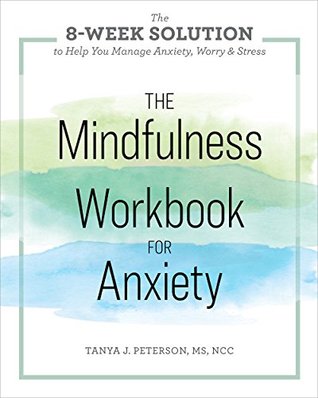More on this book
Kindle Notes & Highlights
The Mindfulness Workbook for Anxiety: The 8-Week Solution to Help You Manage Anxiety, Worry & Stress
Read between
November 20, 2023 - January 11, 2024
Mindfulness can help with the problems of overthinking, because it teaches us to redirect our thoughts and focus our attention with intention and purpose. We attend to what’s around us instead of to anxious thinking, we refocus and consciously choose what we pay attention to.
Awareness balances thinking and reduces anxiety, because while anxiety is focused on the past or the future, awareness is grounded in the present.
If I don’t worry, it means that I don’t care enough.
So many things can go wrong with my body to make me unhealthy.
Things could get so bad that I won’t be able to handle them.
1. Los síntomas se incrementan porque no les pongo suficiente atención.
2. Los síntomas causarán daños en mi cuerpo si no se resuelven prontamente.
3. Pierdo poder de control sobre los síntomas y no los puedo dominar.
4. Me anticipo a la idea que llegarán los síntomas con más fuerza y me debilita pensar en su magnitud.
1. Si mi atención va dirigida a un estímulo diferente (mindfulness) que me genere paz y tranquilidad, dejaré de pensar en los síntomas y no evolucionarán.
2. Sí me consumen bastante energía física, animica y mental, pero no se desarrollarán en enfermedades, pues solo son manifestaciones de atención al peligro irracional.
3. Debo gestionar más no controlar los síntomas, aceptarlos cuando lleguen en su magnitud, entender el para qué se presentan así (nuevo aprendizaje) y conciliar con ellos.
4. Aseguro / anticipo la situación que tendré de ansiedad en el día, lo que alimenta el hecho que con seguridad se presentará el episodio en la magnitud / tamaño de la expectativa irracional.
Letting yourself experience and accept strong emotions helps you deescalate strong feelings.
This is true for everyone, and it’s especially true for people living with anxiety. Anxiety and self-criticism are partners in crime. And self-criticism can be dangerously toxic.
Cultivating compassion teaches us to accept our anxiety, our difficult emotions, and anything else that’s standing in the way of our ability to live the quality life we desire.
The challenge to our mental health and well-being comes when our fear responses become irrational, and we start to fear and avoid things that pose no real threat.
The thought of doing this might be uncomfortable and anxiety provoking, but keep in mind that along the way you’ll also be working on identifying irrational beliefs and developing healthier, more realistic ones.
You’re now questioning the reality of your fears.
Walking mediations bring our attention back to the present moment. They help us stop blindly rushing through life, letting anxiety guide us, and missing out on things that are important to us.
You’ve been cultivating awareness of yourself, your life, and the present moment since the very first week of this program. Self-compassion is a skill cultivated by lovingkindness practice, which can help alleviate the pressure of negative thoughts and worries. And with acceptance, you can learn to be present in your life and live it fully, even when anxiety and panic show up.
You’ve learned how the mind and body are connected. Where one goes, the other follows. If the mind is full of catastrophic thoughts, the body feels it in the form of racing heart, headaches, and general physical discomfort. The mind-body relationship works both ways: if the body is tense, in pain, or otherwise feeling sensations associated with anxiety, the mind interprets these sensations with anxious thoughts. This is why mindfulness works so well for reducing anxiety and panic.
You see, mindfulness, awareness, compassion, and acceptance are powerful tools for reducing anxiety in any given moment.
Mindfulness is a way of life. When you live mindfully, you will become less impacted by anxiety.
In our frenetic, overscheduled lives, taking a break for quiet and reflection can be a real treat! Remember your reason for practicing mindfulness: to live a quality life, free from anxiety’s control. Knowing your purpose will help you stay motivated to continue regular, consistent practice.


